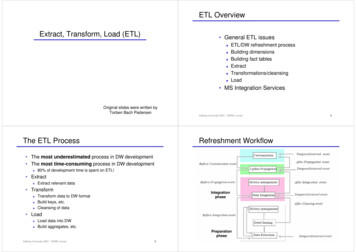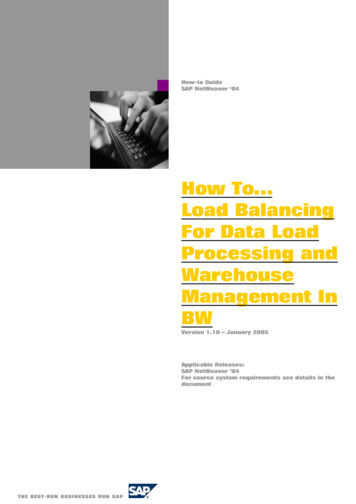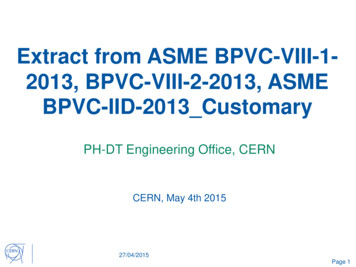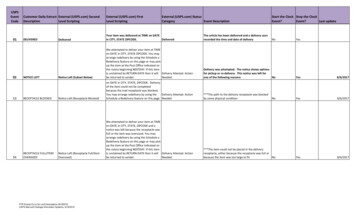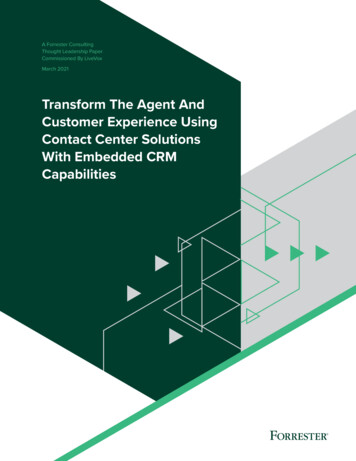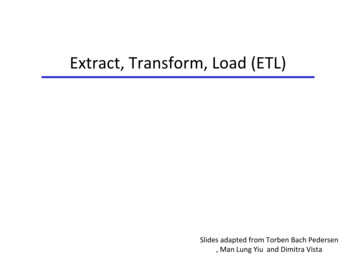
Transcription
Extract, Transform, Load (ETL)Slides adapted from Torben Bach Pedersen, Man Lung Yiu and Dimitra Vista
ETL Overview The ETL Process General ETL issues Building dimensionsBuilding fact tablesExtractTransformations/cleaningLoad MS Integration Services Reading materials Kimball ch. 10;Jarke ch. 4.1-4.3;Supplementary: Designing and Implementing Packages s167031.aspxAalborg University 2008 - DWDM course2
The ETL Process The most underestimated process in DW development The most time-consuming process in DW development 80% of development time is spent on ETL! Extract Extract relevant data Transform Transform data to DW formatBuild keys, etc.cleaning of data Load Load data into DWBuild aggregates, etc.Aalborg University 2008 - DWDM course3
ETL In The ArchitectureQuery sideETL sideMetadataDatasourcesPresentation serversQueryServices-Warehouse Browsing-Access and SecurityData marts withQuery Managementaggregate-only data- Standard ReportingConformed -Activity MonitorDataWarehouse dimensionsBusand facts- Extract- Transform- LoadData StagingAreaReporting ToolsDesktop DataAccess ToolsData miningOperationalsystemData marts withatomic dataDataServiceElementAalborg University 2008 - DWDM course5
Designing the staging area The staging area is owned by the ETL team no indexes, no aggregations, no presentation access, no querying, noservice level agreementsTransformations/cleaning done here Users are not allowed in the staging area for any reason staging is a “construction” site Reports cannot access data in the staging area tables can be added, or dropped without modifying the user community Only ETL processes can read/write the staging area (ETLdevelopers must capture table names, update strategies, loadfrequency, ETL jobs, expected growth and other details aboutthe staging area) The staging area consists of both RDBMS tables and data files(DBMS have become better at this)6Aalborg University 2008 - DWDM course
ETL Construction Process Plan1)2)3)4) Develop One-time historic load process4)5) Make high-level diagram of source-destination flowTest, choose and implement ETL toolDevelop default strategies for common activities, e.g. extraction,dimension management, etcDrill down by target table, each columnBuild and test the historic dimension table loadsBuild and test the historic fact table loadsWhy we considerConstruction of fact tables and automationdimensions before7)Build and test the dimension table incremental load process fact tables?8)9)10)Build and test the fact table incremental load processBuild and test aggregate table / OLAP (you do this later)Design, construct, and test ETL automationAalborg University 2008 - DWDM course8
High-level diagram1) Make high-level diagram of source-destination flow Mainly used for communication purposeOne page only, highlight sources and destinationsSteps: extract, transform, Check Referential IntegrityAdd producttypeDestinationProductAalborg University 2008 - DWDM courseAggregate salesper product per dayExtract timeSalesTime9
The basic structure of a dimension Primary key (PK) Meaningless, unique integerAka as surrogate keyJoins to Fact TablesIs a Foreign Key to Fact Tables Natural key (NK) Meaningful key extracted fromsource systems1-to-1 relationship to the PK forstatic dimensions1-to-many relationship to the PK forslowly changing dimensions, trackshistory of changes to the dimension Descriptive Attributes Primary textual but numberslegitimate but not numbers that aremeasured quantities100 such attributes normalStatic or slow changing onlyProduct price -- either fact ordimension attributeAalborg University 2008 - DWDM course10
Generating surrogate keys for Dimensions Via triggers in the DBMS Read the latest surrogate key, generate the next value, create therecordDisadvantages: severe performance bottlenecks Via the ETL process, an ETL tool or a 3-rd partyapplication generate the unique numbers A surrogate key counter per dimensionMaintain consistency of surrogate keys between dev, test andproduction Using Smart Keys Concatenate the natural key of the dimension in the source(s)with the timestamp of the record in the source or the DataWarehouse.Tempting but wrongAalborg University 2008 - DWDM course11
Building Dimensions Static dimension table Product tableDW key assignment: production keys to DW keys(surrogate) using tableCombination of data sources: find common key?Check one-one and one-many relationships using sorting Handling dimension changes Described in last lectureFind the newest DW key for a given production keyTable for mapping production keys to DW keys must bemaintained and m-MilkMilkCacao-MilkVandSodavand Load of dimension changes Small dimensions: replaceLarge dimensions: load only changesAalborg University 2008 - DWDM courseProduct dimension of FClub vs.Product dimension of a supermarket12
How to check 1 to 1 and 1 to many Sorting 1 to many, given a table product, check if product sku andproduct model are 1: manySELECT product skuCount[*] as row countCount (distinct product model) as model countFROM staging database.productGROUP BY product skuHAVING count (distinct product model) 1Aalborg University 2008 - DWDM course13
The grain of a dimension The definition of the key of the dimension in business terms, what does thedimension represent Challenge: analyze the source systems so that a particular set of fields inthat source corresponds to the grain of the dimension Verify that a given source (file) implements the intended grain Nothing should be returned by this from the source system/file If something is returned by this, the fields A, B and C do not representthe grain of the dimensionselect A, B, C, count(*)from DimensionTableSourcegroup by A, B, Chaving count(*) 1Aalborg University 2008 - DWDM course14
The basic load plan for a dimension Simple Case: the dimension is loaded as a lookup table Typical Case Data cleaning Data conforming Validate the data, apply business rules to make the data consistent, columnvalidity enforcement, cross-column value checking, row de-duplicationAlign the content of some or all of the fields in the dimension with fields insimilar or identical dimensions in other parts of the data warehouse Fact tables: billing transactions, customer support calls IF they use the same dimensions, then the dimensions are conformedData Delivery All the steps required to deal with slow-changing dimensionsWrite the dimension to the physical tableCreating and assigning the surrogate key, making sure the natural key iscorrect, etc.15Aalborg University 2008 - DWDM course
The basic structure of a fact table Every table defined by itsgrain in business termsin terms of the dimension foreignkeys and other fields A set of foreign keys (FK) context for the factJoin to Dimension Tables Degenerate Dimensions Part of the keyNot a foreign key to a Dimensiontable Primary Key a subset of the FKsmust be defined in the table Fact Attributes measurements16
Building Fact Tables Two types of load Initial load of historic data ETL for all data up till nowDone when DW is started the first time , humanVery heavy - large data volumes Incremental update Move only changes since last loadDone periodically (e.g., month or week) after DW start, automaticallyLess heavy - smaller data volumes Dimensions must be updated before facts The relevant dimension rows for new facts must be in placeSpecial key considerations if initial load must be performed againAalborg University 2008 - DWDM course17
Guaranteeing Referential Integrity1.2.3.Check Before Loading Check before you add factrecords Check before you deletedimension records Best approachCheck While Loading DBMS enforces RI Elegant but typically SLOW Exception: Red Brick databasesystem is capable of loading 100million records an hour into afact table where it is checkingreferential integrity on all thedimensions simultaneously!Check After Loading No RI in the DBMS Periodic checks for invalidforeign keys looking for invaliddata Ridiculously slow18
Types of Data Sources Non-cooperative sources Snapshot sources – provides only full copy of source, e.g., filesSpecific sources – each is different, e.g., legacy systemsLogged sources – writes change log, e.g., DB logQueryable sources – provides query interface, e.g., RDBMS Cooperative sources Replicated sources – publish/subscribe mechanismCall back sources – calls external code (ETL) when changes occurInternal action sources – only internal actions when changes occur DB triggers is an example Extract strategy depends on the source typesAalborg University 2008 - DWDM course19
Extract Goal: fast extract of relevant data Extract from source systems can take long time Types of extracts: Extract applications (SQL): co-existence with other applicationsDB unload tools: faster than SQL-based extracts e.g., MS SQL Export Wizard, MySQL DB dump Extract applications the only solution in some scenarios Too time consuming to ETL all data at each load Extraction can take days/weeksDrain on the operational systems and DW systems Extract/ETL only changes since last load (delta)Aalborg University 2008 - DWDM course20
Common Transformations Data type conversions EBCDIC ASCII/UniCodeString manipulationsDate/time format conversions E.g., unix time 1201928400 what time? Normalization/denormalization To the desired DW formatDepending on source format Building keys Table matches production keys to surrogate DW keysCorrect handling of history - especially for total reloadAalborg University 2008 - DWDM course23
Data Quality Data almost never has decent quality Data in DW must be: Precise Complete No contradictory data: aggregates fit with detail dataUnique DW has all relevant data and the users knowConsistent DW data must match known numbers - or explanation neededThe same things is called the same and has the same key(customers)Timely Data is updated ”frequently enough” and the users know whenAalborg University 2008 - DWDM course24
The high cost of low quality data Wrong price data in retail databases may cost Americanconsumers as much as 2.5 billion in overcharges annually. Dataaudits show 4 out of 5 errors in prices are overcharges.(Information Week Sept 1992) The Gartner group estimates for the worldwide costs to modifysoftware and change databases to fix the Y2K problem was 400 600 billion. T.Capers Jones says this estimate is low, it should be 1.5 trillion. The cost to fix this single pervasive error is oneeighth of the US federal deficit ( 8 trillion Oct 2005). Another way to look at it. The 50 most profitable companies inthe world earned a combined 178 billion in profits in 1996. Ifthe entire profit of these companies was used to fix the problem,it would only fix about 12% of the problem And MS Excell, in year 2000, still regards 1900 as a leap year(which is not).Aalborg University 2008 - DWDM course25
cleaning Why cleaning? Garbage In Garbage Out BI does not work on “raw” data Pre-processing necessary for BI analysis Handle inconsistent data formats Spellings, codings, Remove unnecessary attributes Production keys, comments, Replace codes with text (Why?) City name instead of ZIP code, e.g., Aalborg Centrum vs. DK-9000 Combine data from multiple sources with common key E.g., customer data from customer address, customer name, Aalborg University 2008 - DWDM course26
Types of cleaning Conversion and normalization Most common type of cleaningText coding, date formats e.g., 3/2/2008 means 3rd February or 2nd March? Special-purpose cleaning Look-up tables, dictionaries to find valid data, synonyms, abbreviationsNormalize spellings of names, addresses, etc.Remove duplicates, e.g., duplicate customers Domain-independent cleaning Approximate, “fuzzy” joins on records from different sourcesE.g., two customers are regarded as the same if their respective values match formost of the attributes (e.g., address, phone number) Rule-based cleaning User-specifed rules: if-then styleAutomatic rules: use data mining to find patterns in data Guess missing sales person based on customer and itemAalborg University 2008 - DWDM course27
cleaning Should a “special” value (e.g., 0, -1) be used in your data? Why this issue is relevant to query/analysis operations? Mark facts with Data Status dimension Normal, abnormal, outside bounds, impossible, Facts can be taken in/out of analyses Uniform treatment of NULL Use explicit NULL value rather than “special” value (0,-1, )Use NULLs only for measure values (estimates instead?)Use special dimension key (i.e., surrogate key value) for NULLdimension values E.g., for the time dimension, instead of NULL, use special key values torepresent “Date not known”, “Soon to happen”Avoid problems in joins, since NULL is not equal to NULL Mark facts with changed status New customer, Customer about to cancel contract, Aalborg University 2008 - DWDM course28
Improving Data Quality Appoint “data quality administrator” Responsibility for data qualityIncludes manual inspections and corrections! Source-controlled improvements The optimal? Construct programs that check data quality Are totals as expected?Do results agree with alternative source?Number of NULL values? Do not fix all problems with data quality Allow management to see “weird” data in their reports?Such data may be meaningful for them? (e.g., fraud detection)Aalborg University 2008 - DWDM course29
Load Goal: fast loading into DW Loading deltas is much faster than total load SQL-based update is slow Large overhead (optimization, locking, etc.) for every SQL callDB load tools are much faster Index on tables slows load a lot Drop index and
Aalborg University 2008 - DWDM course 3 The ETL Process The most underestimated process in DW development The most time-consuming process in DW development 80% of development time is spent on ETL! Extract Extract relevant data Transform Transform data to DW format Build keys, etc. cleaning of data Load Load data into DW Build aggregates, etc.File Size: 691KBPage Count: 44
